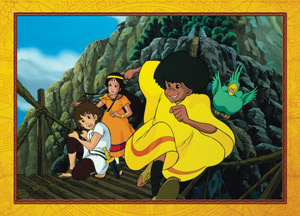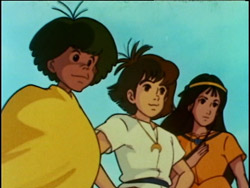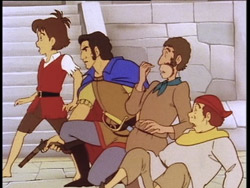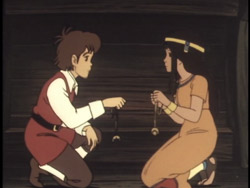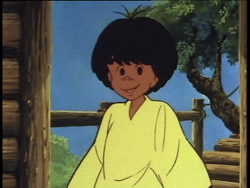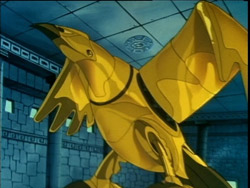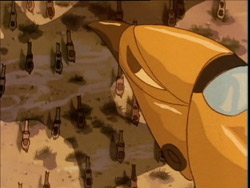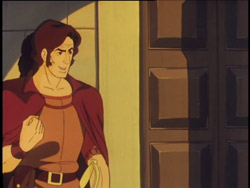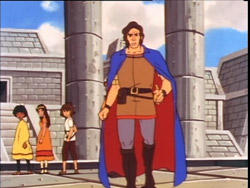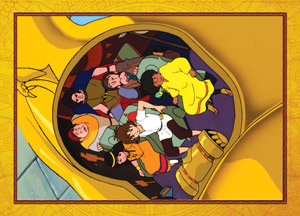 Logo handmade by Bannister
Column by Scott Green
Logo handmade by Bannister
Column by Scott Green
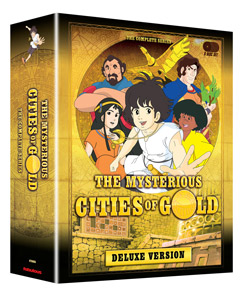
Anime Spotlight: The Mysterious Cities Of Gold Released by Fabulous Films Inc
"TV on DVD" has evolved to a point where the proposition of finally having the opportunity to acquire a beloved children's animated show on the format provokes questions as much as it does excitement. "Does the fondly remembered work hold up to the scrutiny of modern eyes?" "Am I going to laugh at it or cringe at the notion that I once enjoyed it?" "Given current expectations, is this anything that would interest an audience without a nostalgic attachment?" The most casual observer would spot that Mysterious Cities of Gold's early 80's cell animation looks far different from today's digital fair. Additionally, there is English dub work among the supporting cast that's frankly terrible. I'd argue that despite the short cuts inherent in the style of production being in full evidence, the former is a difference worth appreciating, and that suffering through the occasional gratingly voice character for the few episodes that their role lasts is not too severe. Ultimately these deficits or, depending on the audience, potential deficits, are more than compensated for by a well told children's adventure with surprising sophistication in addition to its effecting sense of wonder and sense of place. I find that many children of the 80's have murky memories of the cartoons that they used to watch on Nickelodeon as that MTV of cable children's programming picked up steam. If you mention Belle and Sebastian, Bananaman, Maya the Bee or Noozles, the name may provoke some vague recollections. It seems like the shows with evocative theme songs were the ones that effectively etched themselves into the memory of this generation. There's the Cosgrove Hall series, Danger Mouse and count Duckula, and then there's the one that few can forget... the Mysterious Cities of Gold."Its the 15th century. From all over Europe, great ships sail west to conquer the new world, the Americas. The men eager to seek their fortune, to find new adventures and new lands. They long to cross uncharted seas and discover unknown countries. To find secret gold on a mountain trail high in the Andes. They dream of following the path of the setting sun that leads to El Dorado, and the Mysterious Cities of Gold." "Someday we will find, the Cities of Gold!" Loosely based on Scott O'Dell's Newbery honored The King's Fifth, the French/Japanese collaboration was animated by Studio Pierrot (Naruto, Bleach) from a script by Bernard Deyries, Jean Chalopin and Mitsuru Kaneko. There are some noteworthy connections in the production credits, but not the ones some might expect. Jean Chalopin and Bernard Deyries had previously produced another French-Japanese animated series called Ulysses 31. The music for show was produced by mogul-to-be Haim Saban, along with Shuki Levy. Contrary to some speculation/misremembering, the series has nothing to do with Hayao Miyazaki and almost nothing to do Studio Ghibli or its antecedents. Character designer Toshiyasu Okada was a key animator of Grave of the Fireflies and an animation director on Dog of Flanders, which featured the work of Hayao Miyazaki and Isao Takahata, but that's about the extent of the significant crossover. Caught up in the Conquistadors' attempt to exploit South America for its gold resources, the series follows three children hoping to discover living relatives and the true histories in the sought after, legendary Cities of Gold. Esteban is twelve years old, presumed to be an orphan after Spanish navigator Mendoza saved the infant Esteban when he and his father were lost at see. Raised by the Church in Barcelona, Esteban is reputed to be the "Child of the Sun," capable of convincing the sky to clear up in the midst of storms. Also in Spain, the series introduces Zia, the daughter of an Incan priest who was kidnapped and given to the Queen. Through some convincing and some coercion, Esteban and Zia, along with Mendoza and his far less competent cohorts - rotund, stuttering Sancho and Lupin III-ish Pedro, are sent on a Spanish expedition to locate the Seven Cities of Gold. These protagonists contend with the powers that be during the oceanic voyage, particularly Commander Gomez, a military/political figure who reports to Governor Pizarro, and Captain Gaspard, Gomez's burly martial second. The onboard power-plays are put to an end when a ship wreck causes Esteban, Zia, Mendoza, Sancho and Pedro to be ship wrecked on the Galapagos. There, they meet the third of Mysterious Cities of Gold's trio of child adventurers, Tao - the last descendant of the once advanced Hiva (not to be pedantic, but it's interesting that it's the lost continent of Mu in the non-English versions of the series), who, despite his age and isolated upbringing, is quite clever and informed. With the discovery of a Hiva solar powered/mechanical ship, this group is able to travel to the continent where they contend with the Spanish, find more wondrous inventions such as the memorable golden condor plane, and encounter Incas, Amazons and Mayans, in addition to other, lost tribes. Especially after series like Oban Star Racers and Avatar: The Last Airbender, it is possible to oversell Mysterious Cities of Gold's character work. Yet, it still deserves credit for strongly developing Esteban, Zia, Tao and Mendoza. It presents an energetic, age appropriate triangle between Esteban, Zia and Tao. Esteban and Tao initially butt heads due to the formers proclivity for being quick thinking but also quick to act and the latter being self satisfied in the depth of his knowledge. As it progresses, the series gives these characters plenty of credit. The self sacrificing nobility is as expected from this sort of quest, but what's noteworthy is how both Esteban and Tao apply their minds to political and martial tactics without losing their virtue or pure motives. With Tao this takes the form of inventions. With Esteban, it's more subtle and interesting. On several occasions, Esteban achieves an aim by dissembling or outright lying without being corrupted in the process or being depicted in a negative light as a consequence of his machinations. Throughout Mysterious Cities of Gold, there are certain challenges that only Zia can meet due to her Incan heritage, but, for the most part, her place as a character bookends the series. Early on she exhibits bravery and determination that the adult males are forced to respect. That said, her character trajectory is not one with which feminists will be entirely enamored. While she keeps pace with Esteban and Tao, she is less likely to effect a situation, less agency than the others. This is encapsulated in the character cuts in the opening credits sequence. Esteban jumps up, kicking off his shoes. Tao leaps, spread eagle into the air. Zia wipes a tear from her eye and smiles sweetly. From an adult perspective, the resolution of Zia's story may not feel like optimal treatment of the character. Mendoza is another character that doesn't hold up as well from a contemporary, adult perspective. Watching him competently maneuver through the situation attempting to shape it to his own aims is still entertaining, but the Han Solo evolution from likable, if dangerous, rogue to more stalwart ally now feels very familiar. The Mysterious Cities of Gold is set apart from its contemporaries, particularly, the contemporaries that made it to North America by its long form story telling and characterizations. While the series could be faulted for rushed, forgettable or in some cases omitted resolutions to its plot threads, it does have an effective episode to episode continuity. Momentum is built up as the heroes and villains trace clues in a race for the Cities of Gold. To the extend that there's empathy for the characters, and to the extend that there's a desire to see the characters succeed, this current in the story matters, but the real function as the precarious situation of one episode either spills into or sets the stage for the next is how the events pave the route for the quest. As part of that carry through, as they're swept up in the plot, the characters do, literally, move. From the ocean voyage, to the Andes to the Amazon, from the Incans to the Mayans; Esteban, Zia and Tao traverse the Americas, experiencing a geographic and cultural spectrum in the journey. As the scenery changes, the series rewards discovery. Nothing in Mysterious Cities of Gold is set on a generic landscape. Between weather, buildings, and vegetation, the animators labored to produce composite images that convey scale, as well as a specific, place, time and situation. Even compared to modern, big budget production, its imagery of clouds sitting on a mountain top as seen from the terrace of a summit temple or splotches of overcast sky as seen from the precarious spot in the middle of a gorge spanning rope bridge are moving. Watching Esteban and his companions fly over the Nazca valley in their golden condor is as magical as childhood memories painted the show. There are several aspects of the series and its packaging of which responsible content selectors should be aware before deciding whether to show their children The Mysterious Cities of Gold. Its violence is not notably more frequent, intense or graphic than most current children's shows. The weapons are real, historical ones, such as knives, swords, arrows and canons, which is a distinction from the fantastic gloss that is usually seen these days. However, the real differentiating factor is the explicit consequence of the violence. While few people are actually injured or die, The Mysterious Cities of Gold does note that that is the intension of much of the conflict. These people are trying to hurt each other, and in some cases, they actually accomplish it. Beyond the content of the animated series, episodes are concluded with brief live action mini-documentaries, not shown when the series aired on Nickelodeon. These address the modern and ancient cultures of Latin America, speak to subjects such as sea navigation and the unique species of the Galapagos and retell the legends of the lands' peoples. Starting with the first documentary, I can see potentially objectionable material in these. I will probably give a set of the series to a friend with three daughters younger than its cast If it upsets the kids or if the parents watch with them, I wouldn’t be surprised to get some grief when the first documentary talks about how the Aztecs would "drug" and "sacrifice" girls - complete with reenactment. In fact, one of the boxes in the mosaic title screen to the documentaries shows a young woman struggling as she's held down onto an alter. I'm not as worried about footage of topless women living a pre-modern lifestyle, but I still imagine that it'll be an issue for the content selecting adults in the lives of some children when it crops up in a few of the mid to latter documentaries. Revisiting cherished children's shows has proven to be a treacherous endeavor. More often than not, it results in being mugged by a series that enthralled you in you're younger days. Mysterious Cities of Gold is a delightful exception. While by no means perfect, it is smart enough and beautiful enough that audiences with a childhood attachment, as well as new viewers, will find Mysterious Cities of Gold to be a rewarding experience. In addition to how surprisingly well the series holds up, there is a surprising amount of bonus material packaged with it. The 39 episode work is included in six discs, each of which has bonus features, including behind the scenes documentaries, deleted scenes, alternative versions, storyboards, cast biographies - in this case proving to be interesting, and other legitimately fun pack-ins such as the dubbing cast recreating a scene. This is the rare instance where bonuses are more than back-of-the-box-bullet points, and are in fact impressive in their quantity and in what they bring to the release. As an aside, I don't think Mysterious Cities of Gold will sell as well as it might have in the heat of the TV on DVD craze, but I do feel/hope it will do a healthy number. What I regret is that historic children's animated series that don't have nostalgic roots in North America have been unable to find an audience. Nadia: The Secret of Blue Water is a fun, Jules Verne inspired adventure from Gainax and Hideaki Anno, the people behind Evangelion; with a loose connection to Hayao Miyazaki. It's been released on DVD several times in North America and always struggled. I don't even think Future Boy Conan, a series that was by Miyazaki would find a place. Ultimately, I suspect it's too late for DVDs of Future Boy Conan, World Masterpiece Theatre and the like, but if you remember Mysterious Cities of Gold fondly or catch it on DVD and want more of its ilk, Nadia: The Secret of Blue Water is still available. 